Abstract
In recent decades, the use of plants as a natural remedy has been widely applied in traditional medicine and the treatment of various diseases, including cancer. However, in order to confirm the potential benefits of anticancer drug development from natural sources, in-depth screening assessments are necessary. In the present study, we aimed to evaluate the cytotoxic effects of eight medicinal plants against breast carcinoma and hepatocellular carcinoma cell lines. Remarkably, among all the tested plant extracts, Pyracantha angustifolia and Paullinia cupana extracts showed maximum inhibition in the two cancer cell line models, as detected by cell viability assays, but not in normal mammary epithelial cells. Moreover, induction of cell cycle arrest was seen in both cancer cell models after treatment with extracts derived from the fruits of P. angustifolia and the seeds of P. cupana. Phytochemical and antioxidant analyses demonstrated the presence of high phenolic and flavonoid contents, including an increase in 2,2-diphenyl-1-picrylhydrazyl (DPPH) activity. The growth inhibition of human breast carcinoma and hepatocellular carcinoma cells mediated by both extracts appears to be associated with apoptosis and upregulated expression of pro-apoptotic genes (caspase-3, caspase-7, tumor suppressor protein-p53, cytochrome c, poly (ADP-ribose) polymerase, p53 upregulated modulator of apoptosis, and Bcl-2-associated X-protein). Together, these results indicate that P. angustifolia and P. cupana offer a promising approach for the development of anticancer agents. However, further detailed research is required to make these plants applicable for therapeutic use.
1. Introduction
Despite the progress of modern therapeutic and diagnostic methods, cancer remains the most challenging disease for medical science. Breast cancer is the most frequently diagnosed cancer and the leading cause of mortality in women worldwide [1]. In addition, recent investigations on the incidence and mortality of liver cancer showed an estimated annual mortality rate of over 650,000 patients globally in 2017, particularly in Asian countries [2,3]. Currently, surgical interventions followed by chemotherapy and adjuvant radiation therapy are frequently used to improve the survival rate of cancer patients. On the other hand, natural products, including medicinal plants, are also routinely utilized in primary health care, mainly in developed countries. Since the emergence of ancient medicine, natural products and chemical compounds derived from plants have been used to treat human diseases for centuries and have received increasing consideration for their potential as novel cancer therapeutic agents over the past several years [4]. An alternative approach to the use of traditional therapeutic methods involves the application of anticancer compounds derived from plants. Additionally, growing evidence suggests the possible use of plant-derived compounds to combat carcinogenesis and associated progression, underlining the significance of these products in cancer treatment. Interestingly, approximately 55% of anticancer drugs are currently formulated from natural products [5]. This expanding area of research continues to explore novel natural products from different plant sources, including the sea, which has a nearly endless supply of resources [6,7], facilitating the analysis of more selective, potent, and less toxic compounds to provide better therapeutic approaches for designing a wide range of new anticancer drugs.
Here, we examined the effects of eight whole-plant extracts (methanol extraction) from different plant species on two human cancer cell lines: Breast carcinoma and hepatocellular carcinoma cell cultures. Among them, Pyracantha angustifolia (fruits) and Paullinia cupana (seeds) were then selected for additional detailed apoptosis research focusing on cell death markers elevated by these crude plant extracts. Pyracantha plants, which are found in South Korea, southern Europe, and southwest China, can reach up to 4.5 m. As an evergreen coniferous plant, Pyracantha has many branches and leaves, flowers, and fruits. Fico et al. showed that one Pyracantha species, P. coccinea, can be used in traditional medicine for diuretic, cardiac, and tonic purposes due to its phenolic and antioxidant activities [8]. In another study, Pyracantha fortuneana (Maxim.) exhibited satisfactory antitumor activity in breast and ovarian cancer cells due to the anti-mutation and anti-oxidation activities of its selenium-enriched polysaccharides [9]. Paullinia cupana, commonly known as guaraná, is a Brazilian plant that is frequently touted for its pharmacological activities in neurodegenerative disorders, such as Parkinson’s disease, due to the high content of methylxanthines and tannins in its seeds [10]. Oliveira et al. suggested that the administration of P. cupana Mart. var. Sorbilis defends neuroblastoma cells from rotenone-induced cytotoxicity [11].
In this study, we hypothesized that different plant extracts might contain diverse molecules with antitumor activities and are very effective in selective cancer cell death. After screening eight medicinal plant extracts, we investigated the anticancer effects of P. angustifolia and P. cupana extracts in more detail as they showed maximum inhibitory activity on breast carcinoma and hepatocellular carcinoma cells without affecting their normal counterparts. We observed that Pyracantha and Paullinia exerted a protective effect in both cancer cell line models, as observed by cell proliferation assays. Analysis with propidium iodide (PI)/RNase revealed that the treatment extracts induced cell cycle arrest with increased expression levels of proteins associated with apoptosis (programmed cell death) in cancer cell line models. Taken together, our results suggest that these two plant extracts demonstrate strong anticancer capabilities by inhibiting cancer cell growth.
2. Experimental Section
2.1. Collection and Identification of Plant Materials
All the plants used in this study were collected, identified, and kindly provided by the Southern Plant Resources Institute (Jeju, Korea). The plant properties are summarized in Table 1.

Table 1.
Overview of eight plant extracts, including their medicinal uses and growing location details.
2.2. Extract Preparation
Prior to extraction, the desired plant parts were powdered using a blender, placed in 70% ethanol, maintained in a shaking incubator for 2 days, and then filtered through filter paper. The filtered extract was concentrated under reduced pressure at 70 °C using a rotary pressure concentrator and powdered using a freeze dryer. The freeze-dried concentrated plant extracts were stored at –20 °C until use. Treatments were performed with different dilutions from the obtained extracts and used for further cell experiments to measure anticancer activities (Figure 1).
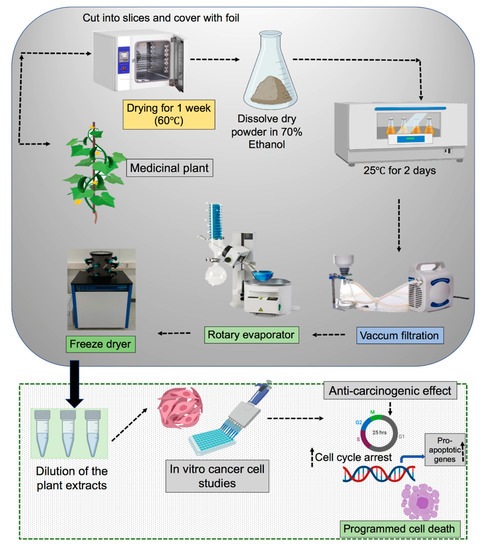
Figure 1.
Schematic illustrations of the extract preparation using various medicinal plants and the cancer cell experimental protocol.
2.3. Cell Culture and Extract Treatments
Human breast carcinoma MDA-MB231 and hepatocellular carcinoma HEPG2 cells were purchased from the Korean Cell Line Bank (Seoul, Korea). The normal human mammary epithelial cell line MCF10A was kindly gifted by Seoul National University (Seoul, Korea). MDA-MB231 and HEPG2 cells were cultured in Dulbecco’s modified Eagle’s medium supplemented with 10% fetal bovine serum, 100 U∙mL–1 of penicillin, and 100 µg∙mL–1 of streptomycin (Gibco, Waltham, MA, USA). MCF10A cells were cultured using a Mammary Epithelial Cell Growth Medium BulletKitTM (Lonza, Basel, Switzerland) according to the manufacturer’s instructions. All cells were maintained in a humidified incubator at 37 °C with 5% CO2 and passaged every 2 to 3 days. After reaching the desired confluence, the cells were seeded for the respective experiments and treated with various concentrations (10, 40, 160, or 320 µg·mL–1) of plant extracts. Stock concentrations were prepared in dimethyl sulfoxide (DMSO), and hydrogen peroxide was purchased from Sigma-Aldrich (Seoul, Korea).
2.4. Radical Scavenging Activity [1,1-diphenyl-2-picrylhydrazyl (DPPH) Test]
The effects of the plant extracts on DPPH [28] radicals were estimated according to the procedure in the literature [29]. To this end, the sample solution (1 mL) was added to 4 mL of a 0.004% methanol solution of DPPH. Ascorbic acid (Sigma-Aldrich) was used as the standard to measure DPPH activity in the samples. The colored test sample absorbance was read at 517 nm in the dark at room temperature after 25 min of incubation using an enzyme-linked immunosorbent assay reader (Epoch; BioTek Instruments, Inc., Winooski, VT, USA).
2.5. Determination of Total Bioactive Components
Total phenolic and flavonoid contents were determined by employing the methods previously described in the literature [30]. To measure the phenolic contents, gallic acid (0.04–200 μg∙mL–1) was used as the standard. The respective concentrations of phenolic compounds present in P. angustifolia and P. cupana were expressed in mg of gallic acid equivalents/g of each extract. However, in the case of flavonoids, quercetin (0.04–200 μg∙mL–1) was used as the standard, and the total flavonoid contents were expressed in mg of quercetin equivalents (QE)/g of each extract.
2.6. Cell Viability Assay
After 24 h of cell seeding in a 96-well plate, the cancer and normal cells were treated with different extract concentrations (10, 40, 160, or 320 µg·mL–1), and cell viability was assessed using alamarBlue (AB; Thermo Fisher Scientific, Waltham, MA, USA) dye after 24, 48, and 72 h of incubation. Briefly, an AB solution (10% v/v) was prepared in the medium, added to each well, further incubated for 1–2 h, and measured using a plate-reading spectrometer (BioTek Instruments, Inc.), as described in our earlier work [31]. Monitored fluorescence was considered a measure of AB dye conversion in the treated and untreated samples. IC50 values were calculated using GraphPad Prism software, where the Fit Spline smoothing curve fitting function was used.
2.7. Cell Cycle Arrest
Seventy-two hours post-treatment with the extracts, the cells were harvested and washed with ice-cold phosphate-buffered saline (PBS) followed by fixation, and permeabilized with 70% EtOH at 4 °C for 12 h. Later, the cells were further washed, resuspended in a staining solution comprising 1 µg·mL–1 RNase A with 5 µg∙mL–1 PI, and incubated in the dark for an additional 20–25 min. After incubation, the stained cells were directly analyzed using a flow cytometer (BD FACSVerse; BD Biosciences, Franklin Lakes, NJ, USA) and FACSuite software. In each test group, 10,000 events/sample were detected.
2.8. Intracellular Reactive Oxygen Species (ROS) Detection
For intracellular detection, the cells were stained with 2’,7-dichlorodihydroflourescein diacetate for 30 min. The cells were washed with cold PBS and analyzed immediately using the BD FACSVerse cytometer and FACS suite software (BD Biosciences) [32].
2.9. Caspase Activity Detection
Caspase-3/7 and caspase-9 activities were measured after 72 h of extract treatment, and all procedures were performed using Caspase-Glo®3/7 and Caspase-Glo®9 Assay kits, respectively (Promega, Seoul, Korea). Luminescence was recorded using a microplate reader in all untreated and treated samples of both MDA-MB231 and HEPG2 cancer cells.
2.10. Quantitative Reverse Transcription-Polymerase Chain Reaction (qRT-PCR) Analysis
TRIzol reagent (RNAiso Plus; Takara Bio, Shiga, Japan) was used to isolate RNA from the cells following the manufacturer’s instructions. Total RNA (2 µg) was used to synthesize the template complementary DNA using MMLV Reverse Transcriptase (Enzymonics, Daejeon, Korea) SuperMix containing 30 mM MgCl2, 750 mM KCl, RT buffer [500 mM Tris-HCl (pH 8.3) and 100 mM DTT], RNase inhibitor, and dNTPs as per the manufacturer’s instructions. The mRNA expression levels of apoptosis-related genes were analyzed with qRT-PCR on an iCycler IQ Real-Time Detection System (Bio-Rad, Hercules, CA, USA).
2.11. Fourier-Transform Infrared (FTIR) and Ultraviolet-Visible (UV-Vis) Spectroscopy Analysis
To examine the presence of active constituents in each extract, FTIR and UV-Vis spectroscopy were used. All eight extracts were placed in the infrared beam output of the FTIR using a Shimadzu QATR-S spectrometer (Kyoto, Japan). Analysis of the acquired oscillatory spectra allows for the estimation of the functional groups with which the radiation interacted. The UV-Vis spectrum of each extract was recorded from diluted extracts (1 mg·mL–1). Each mixture was scanned using a circular dichroism spectrophotometer (JASCO J-815, JASCO, Inc., Easton, MD, USA).
2.12. Statistical Analysis
All data are expressed as the means ± standard deviations of triplicate measurements from three independent experiments. Significant differences between groups were analyzed using the Student’s t-test. Multiple group comparisons were made using one-way analysis of variance. Levels of significance are indicated by *p < 0.05, **p < 0.01, and ***p < 0.001. Nonsignificant groups are denoted as ns.
3. Results
3.1. Analysis of Active Constituents in the Eight Plant Extracts Using FTIR and UV-Vis Spectroscopy
Plant extracts are mixtures of multiple complex phytochemicals, such as organic acids, polyphenols, and polysaccharides [33,34]. To identify the existing functional groups of the plant extracts, we performed chemical analysis techniques, including FTIR and UV-Vis spectroscopy. Figure 2A,B show the measured FTIR spectra of the plant extracts. All of the plant extract spectra show the presence of OH stretching (3308-3318), C-H stretching (2830-2944), O=C=O stretching (2339-2365), C=O stretching (2028-2038), N-H bending (1585-1609), C-H bending (1401-1452), C-O stretching (1108-1111), and C-N stretching (1018-1022). The UV-Vis spectra of the eight plant extracts have absorption bands in the range of 260–400 nm, which indicate the absorption of polyphenols (Figure 2C,D) [35].

Figure 2.
Analysis of phytochemical constituents in all eight plant extracts, including Pyracantha angustifolia and Paullinia cupana. Fourier-transform infrared (FTIR) spectra of (A) Quercus, Sorbus, Saururus, and Paulina; and (B) Dolonix, Colacasia, Ficus, and Pyracantha. UV-Vis absorption spectra of (C) Quercus, Sorbus, Saururus, and Paulina; and (D) Dolonix, Colacasia, Ficus, and Pyracantha.
3.2. Antiproliferative Activity Screening of the Eight Medicinal Plants
In a prescreening of the eight medicinal plants, we tested various concentrations of the plant extracts ranging from 10 to 320 µg·mL–1 against two cancer cell lines: Breast carcinoma MDA-MB231 and hepatocellular carcinoma HEPG2. For plant extract preparation, the parts used are mentioned in Table 1. After attachment, the cancer cell lines were treated with 0, 10, 40, 160, or 320 µg·mL–1 of plant extracts and maintained for the next 72 h to determine time-dependent effects. The results indicate that increasing concentrations of all plant extracts showed cell viability reduction in a concentration-dependent manner at all time points. Remarkably, most of these extracts were able to decrease cell viability by over 50% in both MDA-MBA231 and HEPG2 cancer cells as detected by alamarBlue assays. However, Pyracantha and Paullinia showed the maximum growth inhibition in both types of cancer cell models. The percentage of cell viability in comparison to the vehicle-treated control cells is shown in Figure 3 and Figure 4. We also calculated the half maximal inhibitory concentration (IC50) values of each plant extract against both MDA-MB231 and HEPG2 cancer cells. In the case of MDA-MB231 cells, the IC50 values were as follows: Paullinia (43.1±10.69 µg·mL-1), Saururus (47.46±5.78 µg·mL-1), Sorbus (45.5±22.90 µg·mL-1), Quercus (56.00±15.61 µg·mL-1), Pyracantha (21.91±2.10 µg·mL-1), Ficus (47.93±17.92 µg·mL-1), Colocasia (49.3±11.53 µg·mL-1), and Delonix (76.08±18.96 µg·mL-1). For HEPG2 cells, the IC50 values were as follows: Paullinia (32.57±7.60 µg·mL-1), Saururus (42.50±7.58 µg·mL-1), Sorbus (33.50±5.42 µg·mL-1), Quercus (34.44±14.95 µg·mL-1), Pyracantha (28.41±4.53 µg·mL-1), Ficus (43.59±13.2 µg·mL-1), Colocasia (39.46±7.29 µg·mL-1), and Delonix (34.59±3.45 µg·mL-1). The IC50 values confirm that Pyracantha and Paullinia showed the lowest IC50 against both cancer cell types among all extracts tested (Supplementary Table S1). Since, the reduction in viability was not consistent with increasing concentration of plant extract. Therefore, our IC50 values were higher, calculated from the Prism-based fit Spline, the smoothing curve fitting function, as expected from viability data results. Furthermore, when both these extracts were tested on normal MCF10A mammary cells, Pyracantha and Paullinia did not display any cell toxicity (Figure 5). These results suggest that Pyracantha and Paullinia may have high potential for the inhibition of cell growth against different cancer cell types without inducing much toxicity.
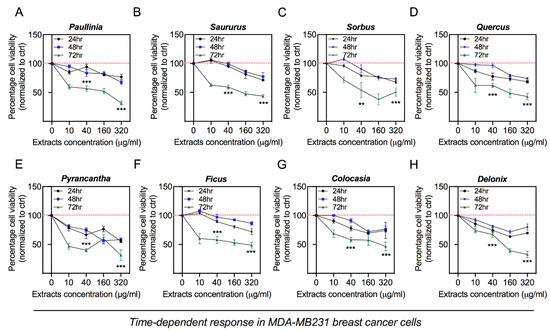
Figure 3.
Cell viability screening analysis of different extracts from eight medicinal plants in human breast carcinoma MDA-MB231 cells. The alamarBlue assay was performed in Paullinia (A), Saururus (B), Sorbus (C), Quercus (D), Pyracantha (E), Ficus (F), Colocasia (G), and Delonix (H) extract-treated (0, 10, 40, 160, or 320 µg·mL–1) cells after 24, 48, and 72 h of incubation. **p < 0.01; ***p < 0.001. Untreated samples were used as controls for all tested plant extracts.
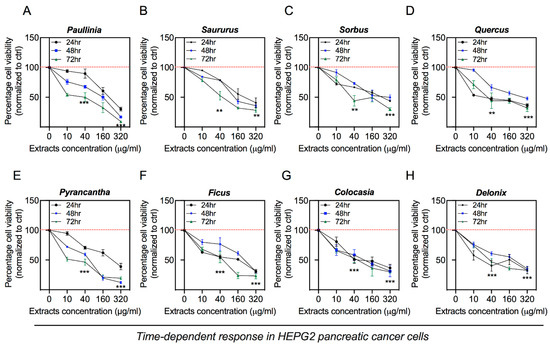
Figure 4.
Cell viability screening analysis of different extracts from eight medicinal plants in human hepatocellular carcinoma HEPG2 cells. The alamarBlue assay was performed in Paullinia (A), Saururus (B), Sorbus (C), Quercus (D), Pyracantha (E), Ficus (F), Colocasia (G), and Delonix (H) extract-treated (0, 10, 40, 160, or 320 µg·mL–1) cells after 24, 48, and 72 h of incubation. **p < 0.01; ***p < 0.001. Untreated samples were used as controls for all tested plant extracts.
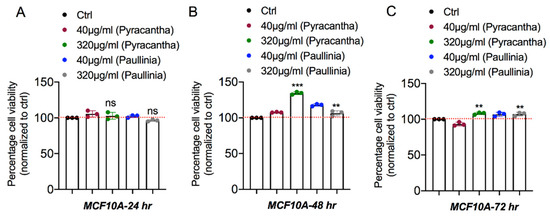
Figure 5.
Pyracantha and Paullinia did not affect normal cell viability. (A–C) alamarBlue assays in normal MCF10A mammary epithelial cells treated with two different concentrations (40 or 320 µg·mL–1) of Pyracantha and Paullinia after 24, 48, and 72 h of incubation. **p < 0.01; ***p < 0.001. Nonsignificance is denoted as ns. Untreated samples were used as controls for all tested plant extracts.
3.3. Pyracantha and Paullinia Induce Cell Cycle Arrest
Next, to investigate whether the inhibitory effects of these two extracts were associated with cell cycle alteration, we performed cell cycle analysis in MDA-MB231 and HEPG2 cancer cells using flow cytometry. In both cancer cell types, after treatment with plant extracts for 72 h, cell cycle distribution was analyzed using PI staining. Our results showed that treatment with both 40 and 320 µg∙mL–1 concentrations of Pyracantha and Paullinia decreased the number of cells in the G0/G1 phase in MDA-MB321 and HEPG2 cancer cells (Figure 6A,B; Supplementary Table S2). An accumulation of cells was also observed in the G2/M phase using these concentrations of both extract samples, which was more significant in HEPG2 cells (Figure 6C,D). However, differences can be observed in the Sub-G1 phase between control samples and treatments for the MDA-MB-231 cells. Our data suggest that Pyracantha and Paullinia extracts are capable of inducing DNA cell cycle arrest in cancer cells.
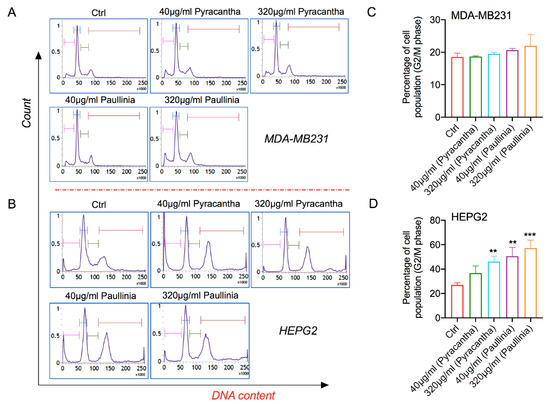
Figure 6.
Pyracantha and Paullinia stimulate cell cycle arrest in both cancer cell types. (A and B) PI/RNase A-stained cells treated with two different concentrations (40 or 320 µg·mL–1) of Pyracantha and Paullinia were analyzed using flow cytometry. The cell populations are marked as sub-G1 (pink), G0/G1 (blue), S (green), and G2/M (brown) in histograms. (C and D) The representative graph shows the percentage of the cell population in the G2/M phase in MDA-MB231 and HEPG2 cancer cells, respectively. Untreated samples were used as controls for all tested plant extracts.
3.4. Pyracantha and Paullinia Stimulate Apoptotic Cell Death
The ability of Pyracantha and Paullinia to suppress cell growth and stimulate cell cycle arrest in cancer cells motivated us to examine whether these extracts have potential to induce programmed cell death or apoptosis. It is well known that apoptotic cell death is carried out by caspases (cysteine aspartyl-specific proteases), which are cysteine proteins that cleave target proteins [36,37,38]. With this goal in mind, we measured caspase-3/7 and caspase-9 activities in both MDA-MB231 and HEPG2 cancer cells treated with 40 or 320 µg·mL–1 extract concentrations. The data showed that Pyracantha and Paullinia increased the caspase activities in both cell types (Figure 7A–D). Remarkably, this effect was more prominent in Paullinia-treated cells upon comparison of both cell types. To verify these phenomena, we assessed the mRNA expression levels of apoptosis-related genes. Treatment with the 320 µg·mL–1 concentration of Pyracantha and Paullinia extracts significantly upregulated the expression levels of caspase-3 (Casp3), caspase-7 (Casp7), tumor suppressor protein-p53 (p53), poly (ADP-ribose) polymerase (Parp), and p53 upregulated modulator of apoptosis (Puma) in HEG2 cancer cells (Figure 8). Interestingly, high expression of cytochrome c (Cytc) suggested the possibility of a mitochondria-mediated apoptosis pathway. These findings indicate that Pyracantha and Paullinia decrease cancer cell growth through apoptosis induction.
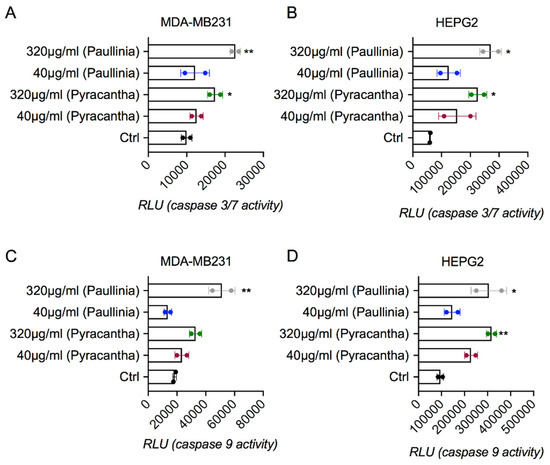
Figure 7.
Pyracantha and Paullinia induce apoptosis in cancer cells. (A and B) Caspase-3/7 activity was measured in MDA-MB231 and HEPG2 cells treated with two different concentrations (40 or 320 µg.ml–1) of Pyracantha and Paullinia extracts, respectively. (C and D) Caspase-9 activity was measured in MDA-MB231 and HEPG2 cells treated with two different concentrations (40 or 320 µg.ml–1) of Pyracantha and Paullinia extracts, respectively.*p < 0.05; **p < 0.01. Untreated samples were used as controls for all tested plant extracts.
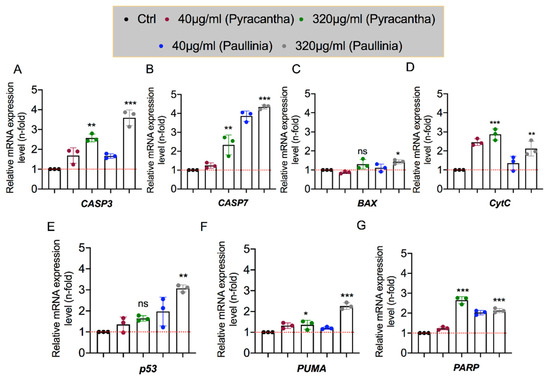
Figure 8.
Apoptosis-related genes were upregulated by Pyracantha and Paullinia in cancer cells. (A–G) Detection of the mRNA expression levels of Casp3, Casp7, BAX, Cytc, p53, Puma, and Parp in HEPG2 cells treated with two different concentrations (40 or 320 µg·mL–1) of Pyracantha and Paullinia after 72 h. *p < 0.05; **p < 0.01; ***p < 0.001. Non-significance is denoted as ns. Untreated samples were used as controls for all tested plant extracts.
3.5. Detection of Polyphenols in P. angustifolia and P. cupana Extracts and Intracellular Redox Status
In plants, antioxidant activity is mainly due to the presence of phenolic compounds, including polyphenols and flavonoids. Flavonoids are also considered critical antioxidants in herbal medicine [39,40]. Our data showed that P. angustifolia and P. cupana have high levels of phenolic, as well as flavonoid, contents (Figure 9A,B). Our study results confirmed that the fruits and seeds of P. angustifolia and P. cupana are good sources of phenols and flavonoids (polyphenols). Therefore, we postulated that both these extracts could have antioxidant potential. To test this possibility, we performed the DPPH scavenging assay, the reaction of which is based on the changing color of free radical solution with tested substances. The decline in absorption values after adding extracts to the radical solution is directly proportional to the quantity of produced DPPH [41]. DPPH measurement was conducted with two different concentrations of extracts, 40 and 320 μg·mL− 1. Remarkably, the highest capacity for DPPH inhibition was observed using the 320 μg·mL− 1 concentration with 73% and 48% in Pyracantha and Paullinia extracts, respectively (Figure 9C). These findings suggest the presence of phenolic and flavonoid compounds in both extracts. To further investigate whether the extracts of Pyracantha and Paullinia inhibit the growth of cancer cells by reducing ROS generation, we monitored the redox status of the HEPG2 extract-treated cells using the oxidation-sensitive fluorescent dye DCFDA. Both extracts showed the smallest effect on ROS generation at the lower concentration (40 μg·mL− 1). Thus, Pyracantha and Paullinia extracts decreased ROS generation in HEPG2 cells in a concentration-dependent manner (Figure 9D,E). ROS generation decreased more significantly at the higher concentration (320 μg·mL− 1), which may be due to increased apoptotic cell death. Earlier reports have suggested that various natural compounds present in plants are capable of combating cancer via inhibition of ROS generation in patients [42,43].
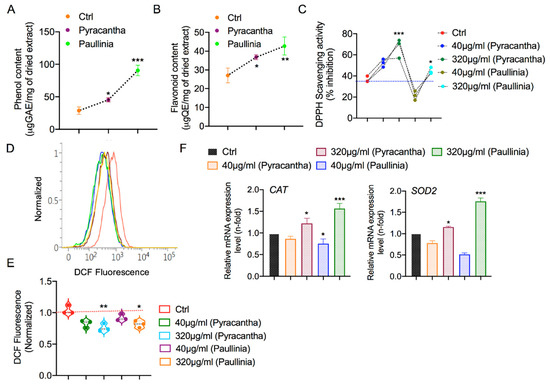
Figure 9.
Determination of phytochemical components and antioxidant activity in Pyracantha and Paullinia extracts. Analysis of phenolic compounds (A), flavonoids (B), and antioxidant scavenging activity (C) in Pyracantha and Paullinia extracts. (D and E) Intracellular reactive oxygen species (ROS) levels in HEPG2 cancer cells following treatment with Pyracantha and Paullinia extracts at the indicated concentrations. (F) qPCR analysis of CAT and SOD2 (MnSOD) antioxidant levels in HEPG2 cancer cells following treatment with Pyracantha and Paullinia extracts at the indicated concentrations. *p < 0.05; **p < 0.01; ***p < 0.001.
Based on this finding, we further assessed the expression levels of antioxidant enzymes, such as catalase (CAT) and manganese-dependent superoxide dismutase (MnSOD or SOD2), in the extract-treated HEPG2 cells. The CAT and SOD2 levels were upregulated at the higher concentration (320 μg·mL− 1) in HEPG2 cancer cells treated with both plant extracts (Figure 9F). These results suggest that antioxidants present in Pyracantha and Paullinia induce the inhibition of cancer cell proliferation through decreased ROS levels. Additionally, we have performed a cell viability test in HEPG2 cells in the presence of H2O2 with both Pyracantha and Paullinia extracts to further validate our findings. Interestingly, H2O2 blocked the effect of both plant extracts on the decrease in viability in cancer cells at the 50 μM concentration (Supplementary Figure S1).
4. Discussion
The extraction of bioactive compounds, such as phenols, from natural products or plant material is influenced by their method of extraction, chemical structure, and the time and conditions of storage [44]. A growing number of studies show that most medicinal plants exhibit antioxidant and anticancer properties due to the presence of chemical components. Antioxidants protect against infections and disease in humans by neutralizing the effects of free radicals. In particular, phenols possess a structural component for free radical scavenging and thus have antioxidant potential [45,46]; as a result, phenols have attracted considerable interest in the field of medicine. Many research studies have proven the antioxidant and anticancer potential of several natural plant extracts in a wide variety of human systems and animal models with relevance to disease [47]. Extracted phenolic compounds show strong protective effects via anti-inflammatory, anti-mutagenic, and anticancer activities [48]. Free radicals play a key role in a wide range of cellular processes by damaging proteins and DNA, leading to many fatal diseases, including cancer [49,50]. Antioxidants can be used for effectively inhibiting cellular proliferation, promoting cell apoptosis, inhibiting gene expression, enhancing detoxification enzymes, and scavenging ROS. Thus, by suppressing oxidative stress and free radicals, phenols and flavonoids promote the amelioration of DNA damage, decreasing the amount of abnormal cell division [51]. In this way, many antioxidant-rich plants exhibit anticancer potential [52,53].
Antioxidants, particularly polyphenols, have been demonstrated as promising agents that can delay cancer initiation and progression [54]. It is believed that flavones may exert their anticancer effects via several possible mechanisms, such as the alteration of cancer cell signaling pathways, removal of carcinogenic agents, antioxidant enzymatic actions, cell cycle arrest, and induction of apoptosis [55]. Most of the anticancer properties correlated with flavanols are supposed to be facilitated by the flavanol epigallocatechin gallate, which has been revealed to prevent cancer cell growth by modifying the expression of cyclin proteins involved in the cell cycle, as well as the activity of cellular signaling proteins involved in proliferation and transformation [56]. In our study, most of the tested medicinal plant extracts protected against breast carcinoma and hepatocellular carcinoma-induced cytotoxicity at a higher concentration (320 µg·mL–1). However, Pyracantha and Paullinia showed the maximum level of inhibition against two different cancer cell types (Figure 2 and Figure 3). It is worth mentioning that both these extracts had no toxic effects on the normal counterparts of the cancer cells, as confirmed in mammary epithelial MCF10A cells (Figure 4). Pyracantha and Paullinia induced cell cycle arrest to stimulate apoptosis in cancer cells, which was consistent in both cancer cell types. A recent report also suggested that another species, P. fortuneana, inhibits cancer cell growth and induces apoptosis due to the presence of selenium-rich polysaccharides [9,57]. Apoptotic cell death in cancer cells may be the means of an intrinsic mitochondria-mediated pathway [58]. In this study, we examined the expression of p53, which is known as a cell cycle regulator that induces cell cycle arrest via Puma transcription, leading to apoptosis in response to many cellular stressors [59,60]. Moreover, p53 translocates to the mitochondria for subsequent release of cytochrome c and pro-caspase-3 activation according to nontranscriptional mechanisms [61]. In addition, p53 physically interacts with the anti-apoptotic protein Bcl-2 through its DNA-binding domain, thus leading to sequestration of pro-apoptotic BAX/BAK proteins and causing the release of mitochondrial cytochrome c in the cells to induce apoptosis [62]. In agreement with these studies, we detected an increase in p53 in both extract-treated cancer cell types, which may induce apoptotic death by similar mechanisms. Notably, Pyracantha and Paullinia appear to upregulate the expression of other apoptosis-related genes, such as Casp3, Parp, Puma, Cytc, Casp7, and Bcl-2-associated X-protein. Accordingly, further studies are required to fully understand the precise mechanism of Pyracantha and Paullinia-induced apoptosis.
Here, we show that high phenol and flavonoid contents are present in the seed and fruit extracts of Pyracantha and Paullinia, which result in significant cancer inhibition activity with strong antioxidant activity. Our results demonstrate that both extracts have potent antioxidant capacities for DPPH radicals, which were highly consistent with their phytochemical profiles. It can be assumed from the results presented here that remarkable sensitivity could be achieved in different cancer types by using both these extracts, which suggests their potential as therapeutic candidates for novel anticancer approaches.
5. Conclusions
In the current study, we found that Pyracantha and Paullinia extracts exhibit significant antioxidant activity due to high phenolic and flavonoid contents. Additional studies on the underlying mechanism of action of these extract compounds are ongoing. Based on the present findings using in vitro experiments, Pyracantha and Paullinia appear to be strong natural antioxidants that may have an impact on the treatment of various cancers, as well as other human diseases.
Supplementary Materials
The following are available online at https://www.mdpi.com/2076-3417/10/21/7543/s1, Table S1: Cytotoxicity (IC50 values μg/ml) for eight plant extracts against MDA-MB231 and HEPG2 cancer cell line calculated at 72 hr (n = 3) using GraphPad prism software based on fit spline smoothing curve fitting function., Table S2: Effects of Pyracantha and Paullinia plant extracts on the cell cycle of cancer cell lines MDA-MB231 and HEPG2. Percentage of cancer cells in the sub-G1, G0/G1, S and G2/M phase were calculated using FACS suite software., Figure S1: Effects of Pyracantha and Paullinia plant extracts on the cell viability of HEPG2 cancer cells in presence of H2O2 treatment (50μM concentration). * p < 0.05.
Author Contributions
Conceptualization, N.K. and J.H.K.; methodology, N.K. and N.K.K.; formal analysis, N.K., H.Y., S.R.J., L.N.N., P.B. and N.K.K.; investigation, N.K., H.Y., S.J. and N.K.K.; resources, N.K., N.K.K., E.H.C. and J.H.K.; writing—original draft preparation, N.K.; writing—review and editing, N.K., N.K.K., E.H.C. and J.H.K.; supervision, N.K. and J.H.K. All authors have read and agreed to the published version of the manuscript.
Funding
This study was partially supported by the Biomaterials Research Fund, The University of Suwon (J.H.K) and by the Basic Science Research Capacity Enhancement Project through a Korea Basic Science Institute (National Research Facilities and Equipment Center) grant funded by the Ministry of Education (2019R1A6C1010013), Republic of Korea. This study was also supported by the National Research Foundation (NRF) of Korea, funded by the Korea government (2016K1A4A391411.
Conflicts of Interest
The authors declare no conflict of interest.
References
- Bray, F.; Ferlay, J.; Soerjomataram, I.; Siegel, R.L.; Torre, L.A.; Jemal, A. Global cancer statistics 2018: GLOBOCAN estimates of incidence and mortality worldwide for 36 cancers in 185 countries. CA Cancer J. Clin. 2018, 68, 394–424. [Google Scholar] [CrossRef] [PubMed]
- Ghouri, Y.A.; Mian, I.; Rowe, J.H. Review of hepatocellular carcinoma: Epidemiology, etiology, and carcinogenesis. J. Carcinog 2017, 16, 1. [Google Scholar] [CrossRef] [PubMed]
- Castelli, G.; Pelosi, E.; Testa, U. Liver Cancer: Molecular Characterization, Clonal Evolution and Cancer Stem Cells. Cancers 2017, 9, 127. [Google Scholar] [CrossRef]
- Newman, D.J. Natural products as leads to potential drugs: An old process or the new hope for drug discovery? J. Med. Chem. 2008, 51, 2589–2599. [Google Scholar] [CrossRef] [PubMed]
- Gordaliza, M. Natural products as leads to anticancer drugs. Clin. Transl. Oncol. 2007, 9, 767–776. [Google Scholar] [CrossRef]
- Simmons, T.L.; Andrianasolo, E.; McPhail, K.; Flatt, P.; Gerwick, W.H. Marine natural products as anticancer drugs. Mol. Cancer Ther. 2005, 4, 333–342. [Google Scholar]
- Marris, E. Marine natural products: Drugs from the deep. Nature 2006, 443, 904–905. [Google Scholar] [CrossRef]
- Fico, G.; Anna, R.B.; Morelli, I.I.; Tome, F. Flavonoid distribution in Pyracantha coccinea plants at different growth phases. Biochem. Syst. Ecol. 2000, 28, 673–678. [Google Scholar] [CrossRef]
- Sun, Q.; Dong, M.; Wang, Z.; Wang, C.; Sheng, D.; Li, Z.; Huang, D.; Yuan, C. Selenium-enriched polysaccharides from Pyracantha fortuneana (Se-PFPs) inhibit the growth and invasive potential of ovarian cancer cells through inhibiting beta-catenin signaling. Oncotarget 2016, 7, 28369–28383. [Google Scholar] [CrossRef]
- Boasquivis, P.F.; Silva, G.M.M.; Paiva, F.A.; Cavalcanti, R.M.; Nunez, C.V.; de Paula Oliveira, R. Guarana (Paullinia cupana) Extract Protects Caenorhabditis elegans Models for Alzheimer Disease and Huntington Disease through Activation of Antioxidant and Protein Degradation Pathways. Oxid. Med. Cell. Longev. 2018, 2018, 9241308. [Google Scholar] [CrossRef]
- De Oliveira, D.M.; Barreto, G.; Galeano, P.; Romero, J.I.; Holubiec, M.I.; Badorrey, M.S.; Capani, F.; Alvarez, L.D. Paullinia cupana Mart. var. Sorbilis protects human dopaminergic neuroblastoma SH-SY5Y cell line against rotenone-induced cytotoxicity. Hum. Exp. Toxicol. 2011, 30, 1382–1391. [Google Scholar] [CrossRef] [PubMed]
- Randrianavony, P.; Ranaovimanoelina, V.J.; Quansah, N.A.T.; Randimbivololona, F. Antigastric ulcer activity of leaves of Pyracantha angustifolia (Franch.) C.K. Schneid in rats. Eur. Sci. J. 2015, 11, 294–303. [Google Scholar]
- Hwang, B.Y.; Lee, J.H.; Nam, J.B.; Hong, Y.S.; Lee, J.J. Lignans from Saururus chinensis inhibiting the transcription factor NF-κB. Phytochemistry 2003, 64, 765–771. [Google Scholar] [CrossRef]
- Bhatt, L.R.; Bae, M.S.; Kim, B.M.; Oh, G.S.; Chai, K.Y. A chalcone glycoside from the fruits of Sorbus commixta Hedl. Molecules 2009, 14, 5323–5327. [Google Scholar] [CrossRef]
- Yang, G.; An, H.J. b-Sitosteryl-3-O-b-glucopyranoside isolated from the bark of Sorbus commixta ameliorates pro-inflammatory mediators in RAW 264.7 macrophages. IMMUNOPHARM IMMUNOT 2014, 36, 70–77. [Google Scholar] [CrossRef]
- Audipudi, A.V.; Chakicherla, B.V.S. Antioxidative and antimicrobial activity of methanol and chloroform extracts of Gmelina arborea Roxb. Int. J. Biotechnol. Biochem. 2010, 6, 139–144. [Google Scholar]
- Rahman, M.; Hasan, N.; Das, A.K.; Hossain, T.; Jahan, R.; Khatun, A.; Rahmatullah, M. Effect of Delonix regia leaf extract on glucose tolerance in glucose-induced hyperglycemic mice. Afr. J. Tradit. Complementary Altern. 2011, 8, 34–36. [Google Scholar]
- Kennedy, D.O.; Haskell, C.F.; Wesnes, K.A.; Scholey, A.B. Improved cognitive performance in human volunteers following administration of guarana (Paullinia cupana) extract: Comparison and interaction with Panax ginseng. Pharmacol. Biochem. Behav. 2004, 79, 401–411. [Google Scholar] [CrossRef]
- Azab, S.S.; Abdel-Daim, M.; Eldahshan, O.A. Phytochemical, cytotoxic, hepatoprotective and antioxidant properties of Delonix regia leaves extract. Med. Chem. Res. 2013, 22, 4269–4277. [Google Scholar] [CrossRef]
- Sohn, E.; Kim, Y.J.; Kim, J.; Jeong, S. Ficus Erecta Thunb. Leaves Protect Against Cognitive Deficit and Neuronal Damage in a Mouse Model of Amyloid-β-induced Alzheimer’s Disease. Res. Sq. 2020. [Google Scholar] [CrossRef]
- Park, S.H.; Oh, T.H.; Kim, S.S.; Kim, J.E.; Lee, S.J.; Lee, N.H. Constituents with tyrosinase inhibitory activities from branches of Ficus erecta var. sieboldii King. J. Enzym. Inhib. and Med. Chem. 2012, 27, 390–394. [Google Scholar] [CrossRef]
- Park, S.H.; Kim, H.J.; Yoon, J.S.; Lee, H.W.; Park, G.C.; Yi, E.Y.; Yoon, G.; Schini-Kerth, V.B.; Oak, M.H. The effect of Quercus salicina leaf extracts on vascular endothelial function: Role of nitric oxide. J. Nanosci. Nanotech. 2016, 16, 2069–2071. [Google Scholar] [CrossRef]
- Moriyama, M.T.; Suga, K.; Mizayawa, K.; Tanaka, T.; Higashioka, M.; Noda, K.; Oka, M.; Tanaka, M.; Suzuki, K. Inhibitions of urinary oxidative stress and renal calcium level by an extract Quercus salicina Blume/Quercus stenophylla Makino in a rat calcium oxalate urolithiasis model. Int. J. Urol. 2009, 16, 397–401. [Google Scholar] [CrossRef]
- Gu, H.A.; Kim, H.; Park, S.N. Antibacterial activity and cream stability of Quercus salicina Blume extract. Korean J. Microbiol. Biotechnol. 2014, 42, 145–151. [Google Scholar] [CrossRef]
- Wardhani, R.; Asri, L.; Rachmawati, H.; Khairurrijal, K.; Purwasasmita, B.S. Physical-Chemical Crosslinked Electrospun Colocasia esculenta Tuber Protein-Chitosan-Poly(Ethylene Oxide) Nanofibers with Antibacterial Activity and Cytocompatibility. Int. J. Nanomed. 2020, 15, 6433–6449. [Google Scholar] [CrossRef]
- Li, H.M.; Hwang, S.H.; Kang, B.G.; Hong, J.S.; Lim, S.S. Inhibitory effects of Colocasia esculenta (L.) Schott constituents on aldose reductase. Molecules 2014, 19, 13212–13224. [Google Scholar] [CrossRef]
- Kundu, N.; Campbell, P.; Hampton, B.; Lin, C.Y.; Ma, X.; Ambulos, N.; Zhao, X.F.; Goloubeva, O.; Holt, D.; Fulton, A.M. Antimetastatic activity isolated from Colocasia esculenta (taro). Anti-Cancer Drugs 2012, 23, 200–211. [Google Scholar] [CrossRef]
- Sarikurkcu, C.; Cengiz, M.; Uren, M.C.; Ceylan, O.; Orenc, T.; Tepe, B. Phenolic composition, enzyme inhibitory, and antioxidant activity of Bituminaria bituminosa. Food Sci. Biotechnol. 2016, 25, 1299–1304. [Google Scholar] [CrossRef]
- Kim, J.H.; Choi, Y.B.; Lee, H.J.; Kim, Y.H.; Kim, J.H.; Sim, J.M.; Sohn, Y.-S. Fourier Transform Ion Cyclotron Resonance (FT-ICR) MASS Spectrophotometric Analysis of Flower Petal from Paeonia lactiflora cv. ‘Red Charm’ and Evaluation of its Functional Activity. Korean J. Plant Resour. 2016, 29, 588–597. [Google Scholar] [CrossRef][Green Version]
- Zengin, G.; Sarikurkcu, C.; Aktumsek, A.; Ceylan, R.; Ceylan, O. A comprehensive study on phytochemical characterization of Haplophyllum myrtifolium Boiss. endemic to Turkey and its inhibitory potential against key enzymes involved in Alzheimer, skin diseases and type II diabetes. Industrial Crops and Products 2014, 53, 244–251. [Google Scholar] [CrossRef]
- Mumtaz, S.; Bhartiya, P.; Kaushik, N.; Adhikari, M.; Lamichhane, P.; Lee, S.J.; Kaushik, N.K.; Choi, E.H. Pulsed high-power microwaves do not impair the functions of skin normal and cancer cells in vitro: A short-term biological evaluation. J. Adv. Res. 2020, 22, 47–55. [Google Scholar] [CrossRef] [PubMed]
- Kaushik, N.K.; Kaushik, N.; Yoo, K.C.; Uddin, N.; Kim, J.S.; Lee, S.J.; Choi, E.H. Low doses of PEG-coated gold nanoparticles sensitize solid tumors to cold plasma by blocking the PI3K/AKT-driven signaling axis to suppress cellular transformation by inhibiting growth and EMT. Biomaterials 2016, 87, 118–130. [Google Scholar] [CrossRef] [PubMed]
- Chang, R. Bioactive polysaccharides from traditional Chinese medicine herbs as anticancer adjuvants. J. Altern Complement. Med. 2002, 8, 559–565. [Google Scholar] [CrossRef] [PubMed]
- Zhang, Y.Q.; Xu, Z.H.; Deng, Y.L. Characterization of flavone glycosides and aglycones in Cephalotaxus sinensis by HPLC-DAD-MS. Anal. Methods-Uk 2011, 3, 1386–1391. [Google Scholar] [CrossRef]
- Chen, W.P.; Wang, X.H.; Chen, F.S. Characterization of nine traditional Chinese plant extracts with specific acid dissociation constants by UV-Vis spectrophotometry. Anal. Methods-Uk 2014, 6, 581–588. [Google Scholar] [CrossRef]
- Li, J.; Yuan, J. Caspases in apoptosis and beyond. Oncogene 2008, 27, 6194–6206. [Google Scholar] [CrossRef]
- Elmore, S. Apoptosis: A review of programmed cell death. Toxicol. Pathol. 2007, 35, 495–516. [Google Scholar] [CrossRef]
- Zaman, S.; Wang, R.; Gandhi, V. Targeting the apoptosis pathway in hematologic malignancies. Leuk Lymphoma 2014, 55, 1980–1992. [Google Scholar] [CrossRef]
- Dragland, S.; Senoo, H.; Wake, K.; Holte, K.; Blomhoff, R. Several culinary and medicinal herbs are important sources of dietary antioxidants. J. Nutr. 2003, 133, 1286–1290. [Google Scholar] [CrossRef]
- Pietta, P.G. Flavonoids as antioxidants. J. Nat. Prod. 2000, 63, 1035–1042. [Google Scholar] [CrossRef]
- Alam, M.N.; Bristi, N.J.; Rafiquzzaman, M. Review on in vivo and in vitro methods evaluation of antioxidant activity. Saudi Pharm. J. 2013, 21, 143–152. [Google Scholar] [CrossRef]
- Fuchs-Tarlovsky, V.; Bejarano-Rosales, M.; Gutierrez-Salmeán, G.; Casillas, M.A.; Ló-pez-Alvarenga, J.C.; Ceballos-Reyes, G.M. Effect of antioxidant supplementation over oxidative stress and quality of life in cervical cancer. Nutr. Hosp. 2011, 26, 819–826. [Google Scholar]
- Mazdak, H.; Zia, H. Vitamin e reduces superficial bladder cancer recurrence: A randomized controlled trial. Int. J. Prev. Med. 2012, 3, 110–115. [Google Scholar]
- Naczk, M.; Shahidi, F. Extraction and analysis of phenolics in food. J. Chromatogr. A 2004, 1054, 95–111. [Google Scholar] [CrossRef]
- Pourreza, N. Phenolic compounds as potential antioxidant. Jundishapur J. Nat. Pharm. Prod. 2013, 8, 149–150. [Google Scholar] [CrossRef]
- Bandoniene, D.; Murkovic, M. On-line HPLC-DPPH screening method for evaluation of radical scavenging phenols extracted from apples (Malus domestica L.). J. Agric. Food Chem. 2002, 50, 2482–2487. [Google Scholar] [CrossRef]
- Aziz, M.H.; Kumar, R.; Ahmad, N. Cancer chemoprevention by resveratrol: In vitro and in vivo studies and the underlying mechanisms (review). Int. J. Oncol. 2003, 23, 17–28. [Google Scholar] [CrossRef] [PubMed]
- Vuorela, S.; Kreander, K.; Karonen, M.; Nieminen, R.; Hamalainen, M.; Galkin, A.; Laitinen, L.; Salminen, J.P.; Moilanen, E.; Pihlaja, K.; et al. Preclinical evaluation of rapeseed, raspberry, and pine bark phenolics for health related effects. J. Agric. Food Chem. 2005, 53, 5922–5931. [Google Scholar] [CrossRef] [PubMed]
- Diplock, A.T.; Charleux, J.L.; Crozier-Willi, G.; Kok, F.J.; Rice-Evans, C.; Roberfroid, M.; Stahl, W.; Vina-Ribes, J. Functional food science and defence against reactive oxidative species. Br. J. Nutr. 1998, 80 (Suppl. S1), S77–S112. [Google Scholar] [CrossRef]
- Valko, M.; Leibfritz, D.; Moncol, J.; Cronin, M.T.; Mazur, M.; Telser, J. Free radicals and antioxidants in normal physiological functions and human disease. Int. J. Biochem. Cell Biol. 2007, 39, 44–84. [Google Scholar] [CrossRef] [PubMed]
- Shigenaga, M.K.; Ames, B.N. Oxidants and mitogenesis as causes of mutation and cancer: The influence of diet. Basic Life Sci. 1993, 61, 419–436. [Google Scholar] [CrossRef]
- Alam, A.K.; Hossain, A.S.; Khan, M.A.; Kabir, S.R.; Reza, M.A.; Rahman, M.M.; Islam, M.S.; Rahman, M.A.; Rashid, M.; Sadik, M.G. The Antioxidative Fraction of White Mulberry Induces Apoptosis through Regulation of p53 and NFkappaB in EAC Cells. PLoS ONE 2016, 11, e0167536. [Google Scholar] [CrossRef] [PubMed]
- Greenwell, M.; Rahman, P.K. Medicinal Plants: Their Use in Anticancer Treatment. Int. J. Pharm Sci. Res. 2015, 6, 4103–4112. [Google Scholar] [CrossRef] [PubMed]
- Di Domenico, F.; Foppoli Coccia, C.R.; Perluigi, M. Antioxidants in cervical cancer: Chemopreventive and chemotherapeutic effects of polyphenols. Biochim. Biophys. Acta 2012, 1822, 737–747. [Google Scholar] [CrossRef] [PubMed]
- Hu, M.L. Dietary Polyphenols as Antioxidants and Anticancer Agents: More Questions than Answers. Chang Gung Med. J. 2011, 34, 449–459. [Google Scholar] [PubMed]
- Khan, N.; Afaq, F.; Saleem, M.; Ahmad, N.; Mukhtar, H. Targeting multiple signaling pathways by green tea polyphenol (−)-epigallocatechin-3-gallate. Cancer Res. 2006, 66, 2500–2505. [Google Scholar] [CrossRef] [PubMed]
- Yuan, C.; Wang, C.; Wang, J.; Kumar, V.; Anwar, F.; Xiao, F.; Mushtaq, G.; Liu, Y.; Kamal, M.A.; Yuan, D. Inhibition on the growth of human MDA-MB-231 breast cancer cells in vitro and tumor growth in a mouse xenograft model by Se-containing polysaccharides from Pyracantha fortuneana. Nutr. Res. 2016, 36, 1243–1254. [Google Scholar] [CrossRef]
- Xu, W.; Jing, L.; Wang, Q.; Lin, C.C.; Chen, X.; Diao, J.; Liu, Y.; Sun, X. Bax-PGAM5L-Drp1 complex is required for intrinsic apoptosis execution. Oncotarget 2015, 6, 30017–30034. [Google Scholar] [CrossRef]
- Uo, T.; Kinoshita, Y.; Morrison, R.S. Apoptotic actions of p53 require transcriptional activation of PUMA and do not involve a direct mitochondrial/cytoplasmic site of action in postnatal cortical neurons. J. Neurosci. 2007, 27, 12198–12210. [Google Scholar] [CrossRef]
- Miyashita, T.; Reed, J.C. Tumor suppressor p53 is a direct transcriptional activator of the human bax gene. Cell 1995, 80, 293–299. [Google Scholar] [CrossRef]
- Marchenko, N.D.; Zaika, A.; Moll, U.M. Death signal-induced localization of p53 protein to mitochondria. A potential role in apoptotic signaling. J. Biol. Chem. 2000, 275, 16202–16212. [Google Scholar] [CrossRef] [PubMed]
- Scorrano, L.; Oakes, S.A.; Opferman, J.T.; Cheng, E.H.; Sorcinelli, M.D.; Pozzan, T.; Korsmeyer, S.J. BAX and BAK regulation of endoplasmic reticulum Ca2+: A control point for apoptosis. Science 2003, 300, 135–139. [Google Scholar] [CrossRef]
Publisher’s Note: MDPI stays neutral with regard to jurisdictional claims in published maps and institutional affiliations. |
© 2020 by the authors. Licensee MDPI, Basel, Switzerland. This article is an open access article distributed under the terms and conditions of the Creative Commons Attribution (CC BY) license (http://creativecommons.org/licenses/by/4.0/).